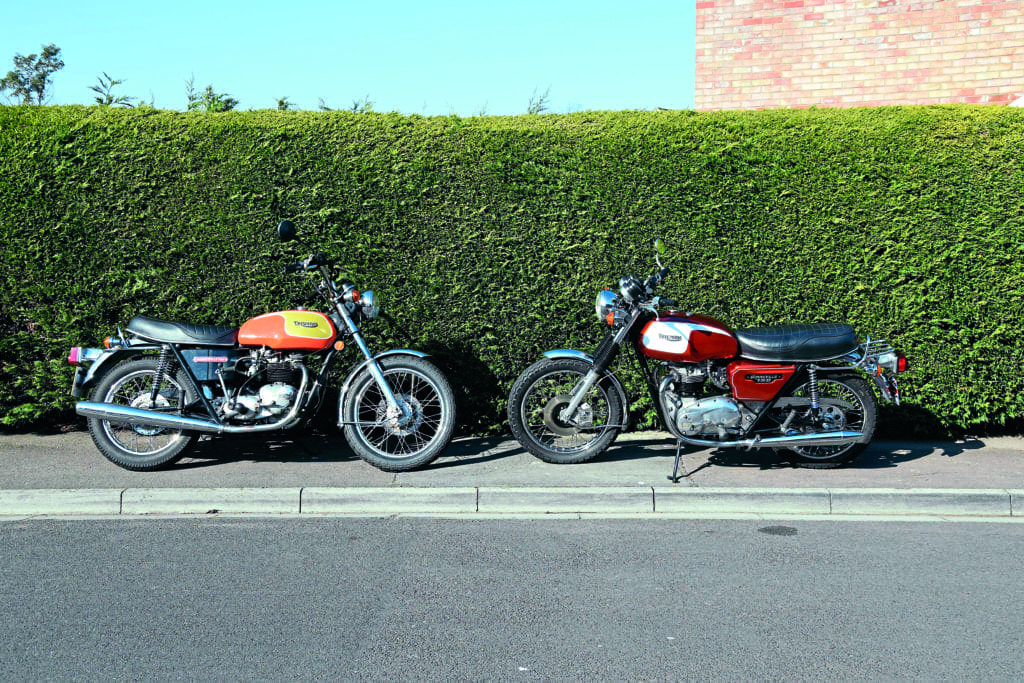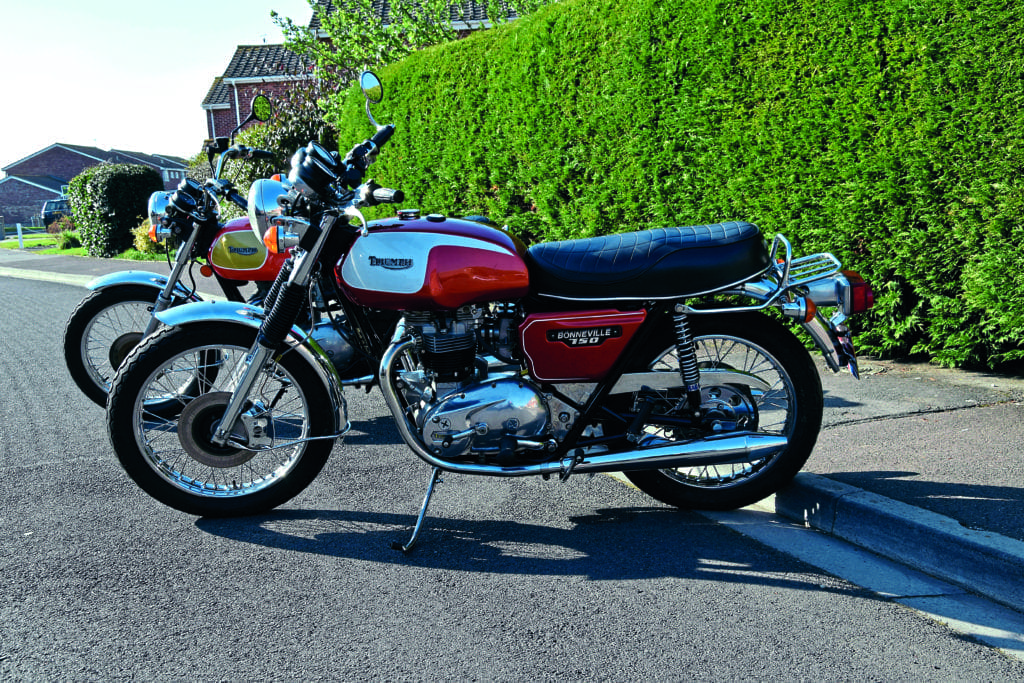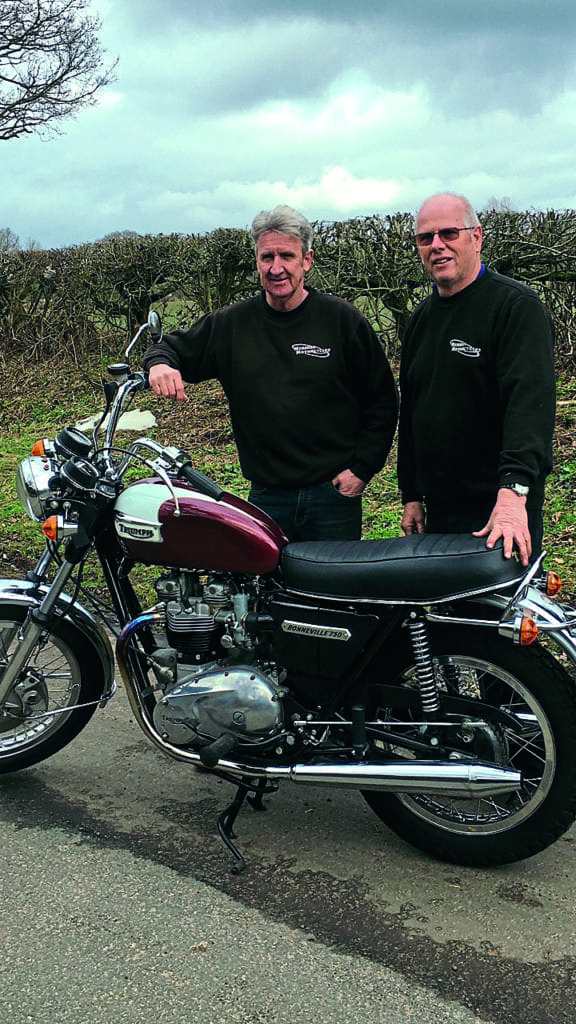If it wasn’t for the T140 Bonneville, would anyone be riding a new Triumph today? Without the T140, Meriden would have closed in the mid-1970s, leaving nothing for John Bloor to buy in 1983. The Triumph workers kept the factory turning out what was an outdated motorcycle long after it should have been consigned to the history books, with Meriden, and later L F Harris building tens of thousands of the oil-in-frame parallel twins. The T140 Bonneville kept the British flag flying.

There are plenty of options for the big twin buyer, but each comes with its own challenges. Most of the AMC twins, apart from the Norton Commando, were out of production by 1968. Royal Enfield Constellations and Interceptors are mostly for those with deep pockets. A BSA unit twin is an option, but good ones are getting pricey and harder to find. As for pre-oil-in-frame Bonnevilles, they’re either eye-wateringly expensive to start with or going to be similarly so to restore.
There are lots of 750 Triumph twins about. Spares availability for a T140 is about as good as it gets – better than anything of the period from the Japanese. You can probably get anything you want for a basic T140 off the shelf or within 24 hours, if you work at it. They are not complicated to work on, though it’s fair to say they can be a little fiddly in some areas. There are plenty of specialist Triumph parts sellers too, some it seems motivated by a love of the breed as much as a profit, and most will help you out.
For more content, why don’t you like our Facebook page here, or follow us on Instagram for a snippet of our striking pictures!
Designed as a sporty tourer, you get almost modern levels of equipment. A Bonnie is a comfy, rapid classic that can lope along all day, stop when you ask it to and blast off into the middle distance occasionally when you open the taps. Find a good A-road and give the big twin a handful and it’ll shoot off like an elderly but over-excited labrador getting the scent of a rabbit.
That’s not to say you can treat a T140 with contempt. Keep an eye on your oil levels, as a T140 can be expected to use a pint every 200 miles, especially if ridden hard. If something starts to leak seriously, it’s not going to stop doing it, so you might as well give it some attention. That oil
filter at the bottom of the tube? Keep it clean, and spotlessly so if you’re replacing it after you’ve taken it out. If you’ve been for a ride, don’t just park the old lady up and expect her to come bouncing back next time.
Owning a T140 will require a healthy collection of AF spanners and sockets and a little mechanical skill. Look after your bike, check the valve clearances, make sure the oil is circulating – what harm can it do to spend two minutes checking the oil level before starting and that it’s returning once you have the engine going?
There is all manner of additions available to make your Bonneville run better. A lot of riders swear by fitting Norton Commando ‘pea-shooter’ silencers in place of the restrictive Triumph items. You can change the wire gauze ‘top hat’ oil filter for a disposable paper item that can make filtering the oil more comprehensive. Points to electronic ignition upgrades won’t do any harm. There are Mikuni carb kits, over-bored aluminium barrels and uprated Morgo oil pumps. You could fit an electric starter kit if you have £2500 lying around, or a belt primary drive. And that’s just the engine.
The front brakes can be upgraded by using later components or stainless steel master cylinders and braided stainless hoses, though some owners feel that these don’t have the feel of the old rubber pipes. How about a solid-state rectifier or a regulator/rectifier, progressive fork springs or more modern shocks?
The riding position, at least for anyone used to a Japanese bike, is unusual. On an export the high bars will stick you up in the wind, while the UK spec low ones have an old-fashioned profile. The bars are rubber mounted in bushes on the top yoke. When pushing the bike around this flexibility is noticeable, but on the move, you barely notice it. You also sit high up on the bike, in the British style. A Bonneville is physically small for a 750, about the same size as a mid-1980s Japanese four-stroke 250. Things will vibrate loose, so a good looking over at stops and after a ride is a good idea. The vibration is such that you are likely to want to stop more frequently in any case. But keep the revs below 5,000 and those vibes won’t bother you unless you are super sensitive.
The T140 had a difficult birth. The original T120 had been the star of the Triumph line-up through the 1960s but in 1971 the company’s masters at BSA launched, with considerable fanfare, a brand-new range of motorcycles, designed at the infamous BSA research facility at Umberslade Hall.
For more content, why don’t you like our Facebook page here, or follow us on Instagram for a snippet of our striking pictures!
The T140 got a stronger triplex primary drive, heavy duty timing side main bearing, thick conrods and a revised cast iron cylinder block. A new cylinder head was held down with 10 studs as opposed to the previous nine. A cautious approach was taken with the first T140 bored to 724cc but soon this was expanded to 744cc when it was clear the beefed-up engine would take it.
US models were fitted with the ‘tear drop’ export tank which was similar in lines to that fitted to the old model, and the new ‘bread bin’ tank fitted to the UK bikes. This was like that fitted to the last T120 and what was left of the BSA A65 range in 1972, but had been tidied up, with the central rib removed, and the rubber mounting bung replaced by a plastic badge. At the time Triumph were criticised for the Bonneville’s vibration which often caused things to fracture and fall off, and the lack of an electric start, but the T140 was never intended to be in production for long. It was going to be a stopgap model while Triumph’s design team came up with something new and better.

The bike entered production in 1973 before deliveries were stalled in 1974 by disputes between NVT and the workers’ co-op. In 1975 the Bonneville was back in the showrooms with 1500 right foot change bikes made before the move to a left foot gearchange for the 1976 models, to cater to the US market.
The 1976 Bonneville also got a rear disc brake replacing the drum and a new set of improved Lucas switchgear on the left-hand end of the bars. The 1977 Bonneville was largely unchanged, barring a few details such as a single piece side panel set up replacing the two-piece arrangement and the loss of the front bracket on the front mudguard.
Despite the vibration, oil leaks and occasional bouts of unreliability, road testers liked the T140, finding the combination of a traditional riding experience with a few modern refinements engaging. Riders did too, especially when Meriden made the US version available in the UK which was a hit with buyers, being a good deal cheaper than smaller capacity foreign rivals. It was in a pleasantly sporty but comfortable state of tune and compared to Japanese competition the handling was of a much higher class. The Bonneville was a capable sports tourer. It might not have been as fast, but in real world motorcycling the T140 was quite capable of keeping up with a flexy-framed Japanese four, and vastly cheaper than anything Italian or German. The T140V was the best-selling 750 in the UK in 1978 and Motor Cycle News readers declared it to be the Bike of the Year, two years running.
For the US market Triumph launched the T140D, in black and gold. Sadly, the Americans had largely fallen out of love with Triumph by now so didn’t buy the T140D in large numbers. It was much more of a hit with British buyers. Today a good T140D is one of the most desirable of the later twins.
For more content, why don’t you like our Facebook page here, or follow us on Instagram for a snippet of our striking pictures!
The following year Triumph also tried to go up-market with the Triumph Bonneville Executive, a tourer in the BMW mould with a smart luggage set up and either a three-quarter or a nose fairing. More significantly that year they launched the Electro, finally fitting an electric start, available as an option on the Executive. A small number of police specials were also made with rubber mounted engines in an unsuccessful attempt to capture that lucrative market, dominated at the time by BMW and the Norton Rotary.
Following the success of the Silver Jubilee special they tried to repeat the trick by creating the Royal Wedding special, which was covered in chrome plate and fitted with an extra front disc. For the 1982 model there was also the release of the eight-valve TSS, using a cylinder head derived from a Weslake original that had been available since the early Seventies. The TSS engine was beefed-up inside and out, and while it was a less attractive mill than the original T140 it was a lot more powerful. It was unfortunate therefore that the first batch of cylinder heads were porous and leaked oil. Continuing to update trim rather than mechanicals, a TSX custom model was launched in the US. The following year the bread bin tank was finally shown the door and the UK Bonneville was to get a new, slimmer tank that bore a marked resemblance to that fitted to Laverda’s Alpino 500 twin.
But for Triumph at Meriden the money had finally run out. By the end of 1982 they couldn’t find the cash to pay wages and the last Bonneville made at Meriden left the factory in January 1983. Triumph didn’t give up – despite having no bikes to sell, they showed off a range at the NEC show in April. But the following month a plan to move the factory from Meriden to a more modern site fell through and the factory was sold to pay debts.
The first close inspection of my T140 indicated that it was clean and complete. Turning on the ignition made the lights come on and the horn beeped, but the indicators did not flash. There was no oil on the dipstick, the gearbox was empty of oil. I gave it a once-over and everything seemed to be there, so, after taking the advice of Garry Watkins, another T140 owner, I topped up the oil tank with a few pints of 20W-50 and freed off the clutch by getting it into second, pulling the clutch lever in and kicking several times until the kick-start no longer felt any resistance. This procedure, I was assured, is common behaviour for T140 owners and is always a good idea if a Bonneville has been left standing, even for as little as a week.
There was a tiny amount of petrol in the tank. Although you shouldn’t do this with any newly acquired motorcycle, I couldn’t resist trying to start it. The twin Amals were tickled and gave it a couple of kicks with ignition off and half a dozen or so kicks with it on, before the beast seemed to be trying to fire. There was another go on the ticklers and after a further half a dozen kicks it started, settling down quickly into a rustling tickover.

Removing the oil filler cap showed that the oil was returning to the tank and the ignition went off. A trip to the shops yielded a litre of mineral EP 90 gearbox oil and a gallon of fresh petrol before I started it up again. This time it fired second kick.
After checking the lubrication levels again and swapping the old battery for the new one in my BSA Starfire, there seemed nothing else to do but take it out on the road. It started up again, and I left it to tickover and warm up a little while riding gear was donned, and set off, with a friend driving behind me in case of emergencies and to pick up anything that fell off.
Going up through the fairly stiff gears as the gear oil bedded in and changing up as the vibes demanded it rather than using the rev counter, I made it to 50mph and once into top, it started to purr with little noticeable vibration. The handling seemed excellent despite the presence of an elderly Avon Roadrunner on the front.
I headed off into the country roads which round my way are pockmarked with potholes, strewn with agricultural waste and covered with strips of inexpertly laid asphalt patches, but for the first time ever I didn’t notice them. There was not so much as a twitch. With the extra current from the alternator, and the fresh battery, the indicators started to work, though the switch was confusing – is it up for right and down for left, or the other way around?
Back at base after a healthy ride of 10 miles, a few tiny oil drips appeared below the engine but that was all. Further rides out have followed. The T140 and I will get along fine.
Want to read on? Then subscribe to Classic Bike Guide and read our magazines online!
For more content, why don’t you like our Facebook page here, or follow us on Instagram for a snippet of our striking pictures!




